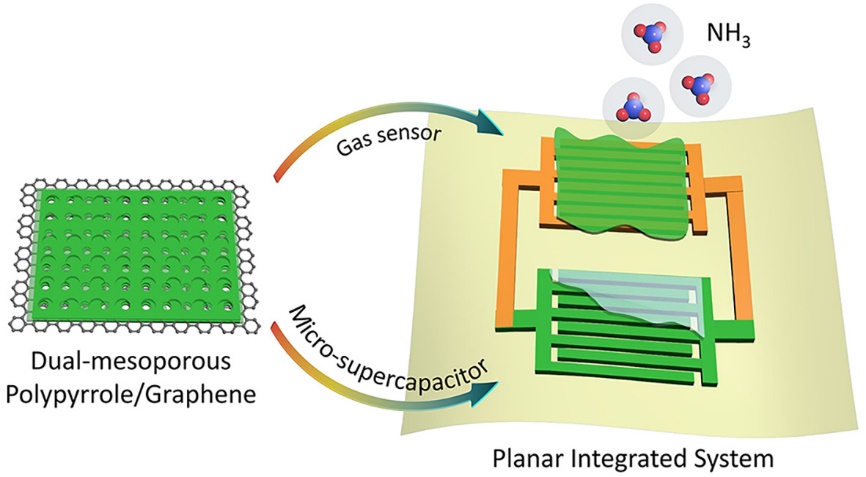A research team led by Prof. WU Zhongshuai, collaborated with the team led by Prof. FENG Liang fomDalian Institute of Chemical Physics (DICP) of Chinese Academy of Sciences, developed a two-dimensional hierarchical ordered dual-mesoporous polypyrrole/graphene (DM-PG) nanosheet as bi-functional active materials for a novel prototype planar integrated system of MSC and NH3 sensor. Their results were published in Advanced Functional Material.
The rapid progress in portable, wearable, and implantable electronics has intensively spurred micro-electrochemical energy storage devices and their integrated systems. In particular, for body-attachable and portable detection of gas pollutants (e.g., NH3, one of the most common gas in industry, agriculture and our daily life), the micro-supercapacitor (MSC)-gas sensor integrated system represents a more and more important core technique of swiftly and reversibly monitoring surrounding gas in real-time to control industrial processes, reduce environmental pollution, and manage physical health.
So far, the most integrated systems are assembled with serial devices based on multiple mono-functional materials. However, the complicated preparation of various mono-functional active materials for single-function energy-related units, and poor compatibility of multiple energy modules involving complex connections, substantially increase the difficulty in the efficient construction of the integrated systems.
Thus, developing dual-functional active materials with both high energy storage and sensitive sensing performance for planar MSC-gas sensor integrated system is highly desirable.

Scheme of two-dimensional dual-mesoporous polymer nanosheets for planar micro-supercapacitor-sensor integrated system. (Imaged by QIN Jieqiong)
The Owing to effective coupling of conductive graphene and high-sensitive pseudocapacitive polypyrrole, well-defined dual-mesopores of ~7 and ~18 nm, hierarchical mesoporous network, and large surface area, the resultant DM-PG nanosheets exhibit extraordinary sensing response to NH3 as low as 200 ppb, exceptional selectivity towards NH3, and outstanding capacitance of 376 F g-1 for supercapacitors.
Importantly, the MSC-sensor integrated system represents rapid and stable response exposed to 10~40 ppm of NH3 only after charging for 100 s, remarkable sensitivity of NH3 detection that is closed to DM-PG based MSC-free sensor, impressive flexibility with ~82% of initial response value at 180°, and enhanced overall compatibility, thereby holding great promise for ultrathin, miniaturized, body-attachable, and portable detection of NH3.
This work was supported by National Natural Science Foundation of China, National Key R&D Program of China, etc. (Text by QIN Jieqiong, GAO Jianmei)